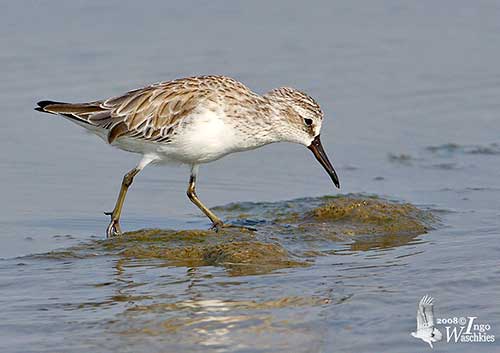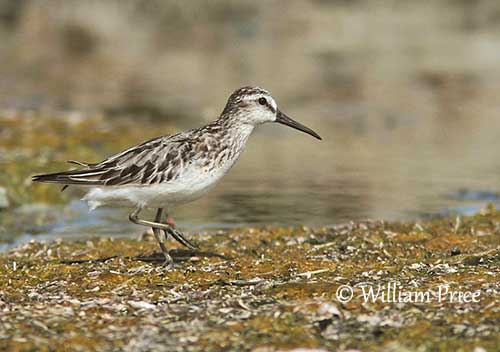
Fr: Bécasseau falcinelle
Ang: Broad-billed Sandpiper
All: Sumpfläufer
Esp: Correlimos Falcinelo
Ita: Gambecchio frullino
Nd: Breedbekstrandloper
Sd: myrsnäppa
Photographers:
Otto Plantema
Trips around the world
William Price
PBase-tereksandpiper & Flickr William Price
Ingo Waschkies
Bird Photography
Text by Nicole Bouglouan
Sources:
HANDBOOK OF THE BIRDS OF THE WORLD Vol 3 by Josep del Hoyo-Andrew Elliott-Jordi Sargatal - Lynx Edicions - ISBN : 8487334202
SHOREBIRDS by Peter Hayman, John Marchant and Tony Prater – Christopher Helm – 1986 – ISBN: 0747014035
THE HANDBOOK OF BIRD IDENTIFICATION FOR EUROPE AND THE WESTERN PALEARCTIC by Mark Beaman, Steve Madge - C. Helm - ISBN: 0713639601
A Field Guide to the Birds of South-East Asia by Craig Robson. New Holland Publishers. ISBN: 9781780090498
GUIDE DES LIMICOLES de D. Taylor - Delachaux et Niestlé - ISBN : 2603014080
BIRDS OF THE MIDDLE EAST by R.F. Porter, S. Christensen, P Schiermacker-Ansen C.Helm - ISBN: 0713670169
What Bird-The ultimate Bird Guide (Mitchell Waite)
Wikipedia, the free encyclopaedia
Birds in backyards (Birds Australia and Australian Museum)
Structure and Vocalizations of Display Flights in the Broad-Billed Sandpiper Limicola falcinellus
Broad-billed Sandpiper
Limicola falcinellus
Charadriiformes Order – Scolopacidae Family
INTRODUCTION:
The Broad-billed Sandpiper is a strongly migratory wader that breeds in Arctic northern Europe and Siberia, and winters from E Africa, through S and SE Asia to Australasia. It frequents a wide variety of wet habitats in all seasons.
This species is smaller, with shorter legs and longer body than Dunlin. The slightly down-curved bill involves typical feeding behaviour in mudflats and tidal areas.
The Broad-billed Sandpiper is threatened by degradation of its wintering areas, pollution and harvesting of benthic fauna. The population is decreasing, but currently, this species is not considered threatened.

DESCRIPTION OF THE BIRD:
Biometrics:
Length: 16-18 cm
Wingspan: 34-37 cm
Weight: 28-68 g
The Broad-billed Sandpiper in breeding plumage has very dark brown upperparts with whitish lines at the edges of the black mantle and scapulars. On the upperwing, the wing-coverts are grey-brown with whitish fringes.
On the underparts, the breast is washed brown and conspicuously streaked blackish. It contrasts with the white belly. Flanks are slightly streaked dark brown.
The head shows striking pattern with blackish crown, double white supercilium joining in front of the eye, blackish eyestripe and dark ear-covert patch.
The adult in worn plumage looks very black above, with strongly streaked breast.
The bill is black, sometimes with yellow tinge at base. It is fairly long and down-curved towards the tip. Seen from above, it is remarkably broad, with parallel sides tapering to a pointed tip.
The eyes are dark brown. Legs and feet are tinged greenish, yellowish or brownish.
Male and female have similar plumage, but the female is slightly larger than male.
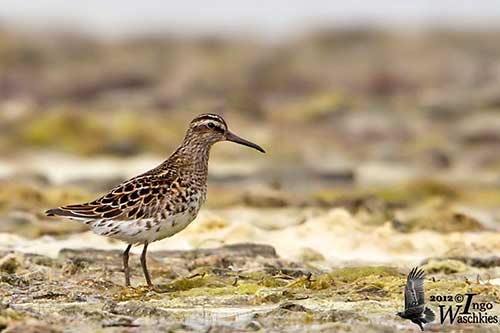
The non-breeding adult has pale grey-brown feathers on crown and upperparts, with conspicuous dark centres or streaks and narrow white fringes.
The underparts are white, except the breast with indistinct grey-brown streaks.
The lower supercilium is white and well-marked, whereas the upper one is less distinct. A dark eyestripe is formed by dark lores and dusky ear-coverts.
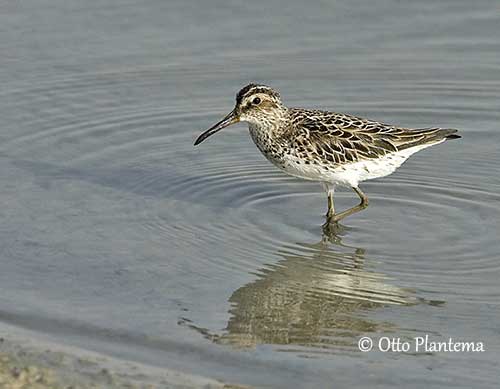
The juvenile resembles breeding adult, but it has chestnut and whitish fringes on mantle, scapulars and tertials. The wing-coverts are broadly fringed buff. The breast is tinged buff-brown with indistinct brown streaks.
SUBSPECIES AND RANGE:
The Broad-billed Sandpiper has two subspecies.
L.f. falcinellus breeds in Scandinavia and NW Russia. It winters from E Africa, through S Red Sea and Arabia to W and S India and Sri Lanka.
L.f. sibirica breeds in NE Siberia (Taymyr and R Lena E to R Kolyma). It winters from NE India through SE Asia, and Indonesia to Australasia.
This race has brighter, more rufous fringes on the upperparts, and the breast is washed cinnamon in breeding plumage. On the head, the upper supercilium is narrower, whereas the lower one is broader. The juvenile shows broader buff fringes than nominate.
HABITAT:
The Broad-billed Sandpiper breeds within large, open, wet bogs in subarctic montane and lowland wet areas, between 200 and 1000 metres of elevation. The race “sibirica” breeds in wet Arctic tundra.
During migration, it occurs at inland wetlands in soft muddy areas around ponds and lakes, also in shallow freshwater to saline, overgrazed meadows, inlets of fjords and flooded ricefields.
During winter, it frequents large intertidal mudflats, and occurs in brackish lagoons and saltpans.
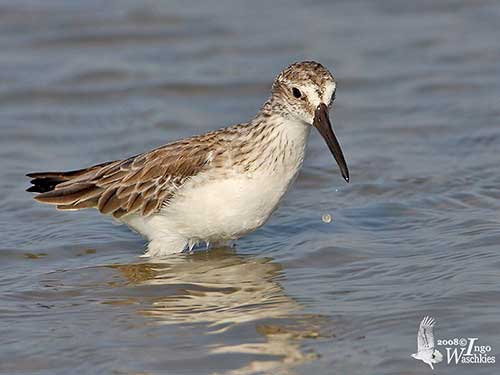
CALLS AND SONGS: SOUNDS BY XENO-CANTO
The Broad-billed Sandpiper in flight gives a dry, buzzing trill “trrreet” or “chrrreeit” and a shorter “trett”.
During the breeding season, it produces rhythmic, mechanical, buzzing trills during the flight display “sprrr-sprrr-sprrr…” interspersed with faster, more whirring trill “swirrirrirrirrirr…”
BEHAVIOUR IN THE WILD:
The Broad-billed Sandpiper feeds on aquatic invertebrates such as marine worms, small bivalves, snails, crustaceans, insects and their larvae, and it also consumes seeds.
Its feeding action is similar to Dunlin, but with the head hold farther in front of the body, and more vertical bill. It forages by walking slowly, but is may make short runs too, while picking from side to side and sometimes probing with the bill.
It forages in soft mud and wet sand, or sometimes by wading in shallow water. It has slow-moving and crouching feeding action.
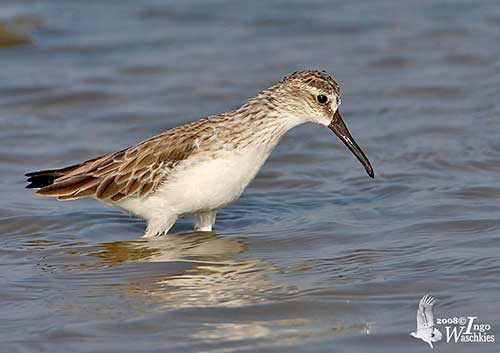
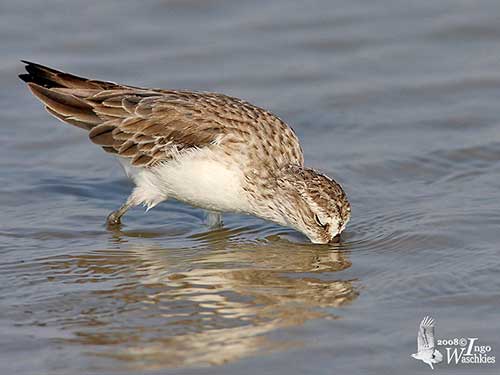
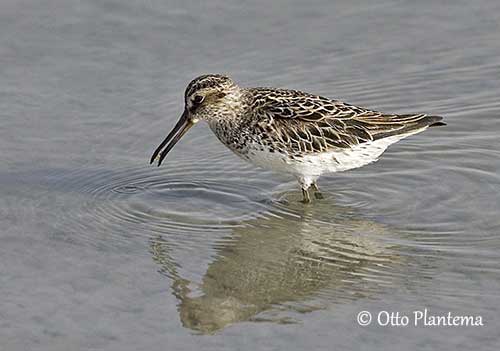
It is often found singly or in small groups during winter, sometimes with other wader species. On migration, they may form larger flocks.
During the breeding season, the male performs aerial displays, and especially a song flight, alternating fast and slow speeds. This flight includes fluttering and gliding sequences at 10-20 metres above the ground. They are monogamous.
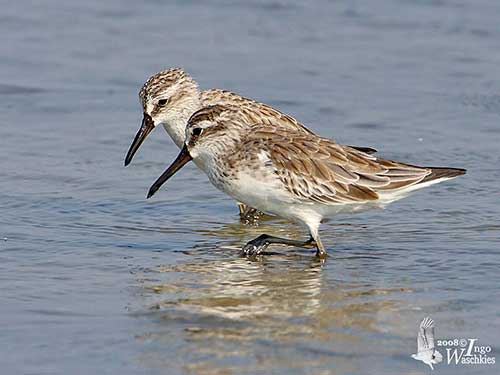
The Broad-billed Sandpiper is migratory and moves S from early July, but the juveniles move mostly from August. They reach the wintering areas between late July and late August respectively, but the migration may continue to late October. They return to their breeding grounds between mid-April and early June.
It migrates singly or in small groups. However, flocks of up to several hundred are common during the spring migration.
The Broad-billed Sandpiper has strong, direct flight.
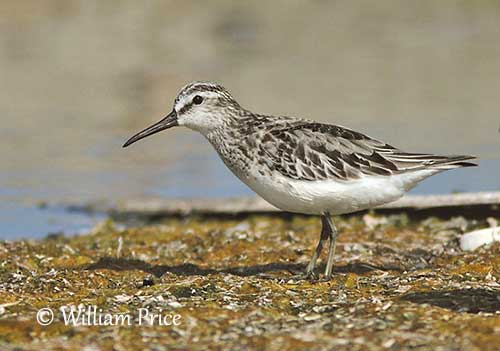
REPRODUCTION OF THIS SPECIES:
The breeding season takes place in spring, with the egg-laying in June in Fennoscandia, and in June/July in Russia. This species produces a single brood per season.
The Broad-billed Sandpiper nests in loose colonies of about ten pairs. The male is strongly territorial and defends the territory by aerial displays. It is aggressive towards other displaying males until the end of the incubation.
The nest is often built on top of tussock, wet sedges or moss cushion. It is a cup-shaped structure made with grass and lined with leaves. It is usually well-raised above the water level.
The female lays 3-4 grey-buff to brown eggs with darker markings. Both adults incubate during three weeks. At hatching, the chicks have chestnut-brown upperparts with black bands, and white underparts with buff-tinged breast. They are first tended by their parents, but later only by the male. The fledging period is unknown.
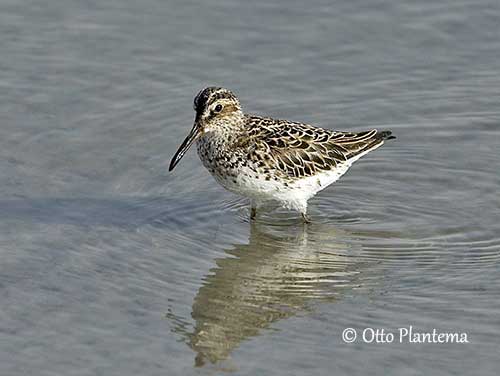
PROTECTION / THREATS / STATUS:
The Broad-billed Sandpiper is threatened by habitat loss in China and S Korea. Both locations are important stopovers during the migration. It suffers the increase of environmental pollution and heavy harvesting of benthic fauna.
The global population was estimated at 71,000/160,000 individuals in 2006. The nominate race is estimated at 13,000/22,000 pairs and the race “sibirica” at 16,000/18,000 individuals. The overall trend is decreasing.
But currently, the Broad-billed Sandpiper is evaluated as Least Concern.
